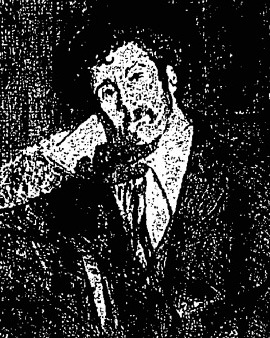


William Turner and James McNeill Whistler - if you can count two of England's most famous painters among your family's circle of acquaintances, you simply have to take up the art subject, even if you come from a simple working class background. Walter Greaves' father was a boat builder and pump attendant on the north bank of the Thames in Chelsea, southwest of central London on what was then the outskirts of the city. Charles Greaves also worked as a boat steersman for Thames tours, and one of his regular customers for boat tours was the well-known nature and landscape painter William Turner, who achieved many a painting object in this way.
Turner probably also awakened Walter Greaves' interest in art; at the age of sixteen he and his brother Henry met another young, aspiring painter - the later famous James McNeill Whistler, who had moved from France to England five years earlier and was also interested in the banks of the Thames. "He taught us painting, and we taught him the craft of the pump master," Greaves would later say.
Under Whistler's guidance, Greaves practiced portraits, created landscapes such as "The Bridge of Hammersmith on Boat Race Day" - where the bridge itself is barely visible in front of crowds of people - and helped Whistler with the decoration of the "Peacock Room", a dining room for the ship magnate Richard F. Leyland. This blue-green treasure is now in the Freer Gallery, Washington D.C. Unfortunately, the artists received little thanks for their creation - Leyland and Whistler threw themselves over for subsequently altered details and continued a feud with mutual teasing for years.
Walter Greaves' cooperation with Whistler also had no future. In the late 1870s Whistler acquired a more educated circle of friends, which the son of a worker from Chelsea could not compete with. While Whistler basked in glory, Greaves fell into oblivion - and poverty. This only changed again after 1900, when William Marchant "discovered" him, owner of the Goupil Galleries, and began exhibiting Greaves' paintings. Even slander - Whistler had died in 1903, two Whistler biographers accused Greaves of plagiarism - could not harm his reputation anymore. In 1922 Greaves was elected honorary president of the Chelsea Artists' Club. From 1855 to 1897, Greaves had only ever lived at Cheyne Walke in Chelsea.
At the age of 80, Walter Greaves sank into poverty once again and decided to spend the last years of his life as inmate of the "London Charterhouse", a kind of retirement home for impoverished gentlemen. He died in 1930 and was buried in Charterhouse Cemetery. Paintings by Walter Greaves still hang in the Tate Gallery today.

William Turner and James McNeill Whistler - if you can count two of England's most famous painters among your family's circle of acquaintances, you simply have to take up the art subject, even if you come from a simple working class background. Walter Greaves' father was a boat builder and pump attendant on the north bank of the Thames in Chelsea, southwest of central London on what was then the outskirts of the city. Charles Greaves also worked as a boat steersman for Thames tours, and one of his regular customers for boat tours was the well-known nature and landscape painter William Turner, who achieved many a painting object in this way.
Turner probably also awakened Walter Greaves' interest in art; at the age of sixteen he and his brother Henry met another young, aspiring painter - the later famous James McNeill Whistler, who had moved from France to England five years earlier and was also interested in the banks of the Thames. "He taught us painting, and we taught him the craft of the pump master," Greaves would later say.
Under Whistler's guidance, Greaves practiced portraits, created landscapes such as "The Bridge of Hammersmith on Boat Race Day" - where the bridge itself is barely visible in front of crowds of people - and helped Whistler with the decoration of the "Peacock Room", a dining room for the ship magnate Richard F. Leyland. This blue-green treasure is now in the Freer Gallery, Washington D.C. Unfortunately, the artists received little thanks for their creation - Leyland and Whistler threw themselves over for subsequently altered details and continued a feud with mutual teasing for years.
Walter Greaves' cooperation with Whistler also had no future. In the late 1870s Whistler acquired a more educated circle of friends, which the son of a worker from Chelsea could not compete with. While Whistler basked in glory, Greaves fell into oblivion - and poverty. This only changed again after 1900, when William Marchant "discovered" him, owner of the Goupil Galleries, and began exhibiting Greaves' paintings. Even slander - Whistler had died in 1903, two Whistler biographers accused Greaves of plagiarism - could not harm his reputation anymore. In 1922 Greaves was elected honorary president of the Chelsea Artists' Club. From 1855 to 1897, Greaves had only ever lived at Cheyne Walke in Chelsea.
At the age of 80, Walter Greaves sank into poverty once again and decided to spend the last years of his life as inmate of the "London Charterhouse", a kind of retirement home for impoverished gentlemen. He died in 1930 and was buried in Charterhouse Cemetery. Paintings by Walter Greaves still hang in the Tate Gallery today.
Page 1 / 1






